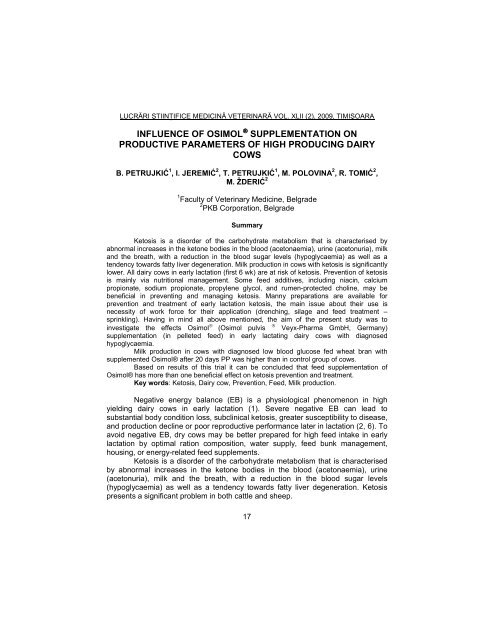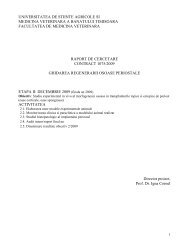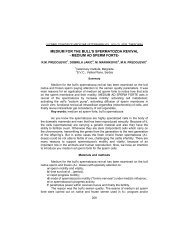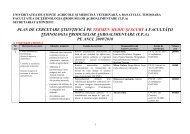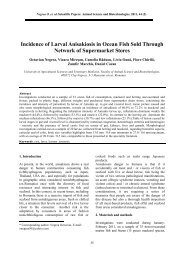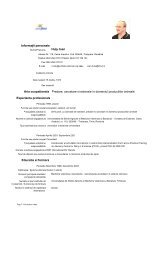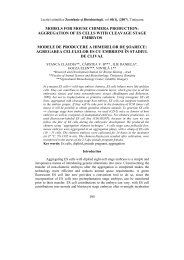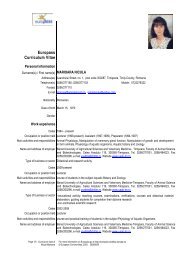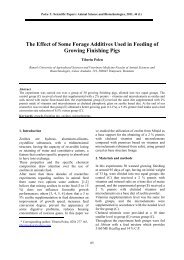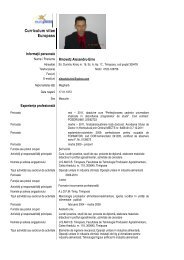influence of osimol® supplementation on productive parameters of ...
influence of osimol® supplementation on productive parameters of ...
influence of osimol® supplementation on productive parameters of ...
Create successful ePaper yourself
Turn your PDF publications into a flip-book with our unique Google optimized e-Paper software.
LUCRĂRI ŞTIINłIFICE MEDICINĂ VETERINARĂ VOL. XLII (2), 2009, TIMIŞOARA<br />
INFLUENCE OF OSIMOL ® SUPPLEMENTATION ON<br />
PRODUCTIVE PARAMETERS OF HIGH PRODUCING DAIRY<br />
COWS<br />
B. PETRUJKIĆ 1 , I. JEREMIĆ 2 , T. PETRUJKIĆ 1 , M. POLOVINA 2 , R. TOMIĆ 2 ,<br />
M. ŽDERIĆ 2<br />
1 Faculty <str<strong>on</strong>g>of</str<strong>on</strong>g> Veterinary Medicine, Belgrade<br />
2 PKB Corporati<strong>on</strong>, Belgrade<br />
Summary<br />
Ketosis is a disorder <str<strong>on</strong>g>of</str<strong>on</strong>g> the carbohydrate metabolism that is characterised by<br />
abnormal increases in the ket<strong>on</strong>e bodies in the blood (acet<strong>on</strong>aemia), urine (acet<strong>on</strong>uria), milk<br />
and the breath, with a reducti<strong>on</strong> in the blood sugar levels (hypoglycaemia) as well as a<br />
tendency towards fatty liver degenerati<strong>on</strong>. Milk producti<strong>on</strong> in cows with ketosis is significantly<br />
lower. All dairy cows in early lactati<strong>on</strong> (first 6 wk) are at risk <str<strong>on</strong>g>of</str<strong>on</strong>g> ketosis. Preventi<strong>on</strong> <str<strong>on</strong>g>of</str<strong>on</strong>g> ketosis<br />
is mainly via nutriti<strong>on</strong>al management. Some feed additives, including niacin, calcium<br />
propi<strong>on</strong>ate, sodium propi<strong>on</strong>ate, propylene glycol, and rumen-protected choline, may be<br />
beneficial in preventing and managing ketosis. Manny preparati<strong>on</strong>s are available for<br />
preventi<strong>on</strong> and treatment <str<strong>on</strong>g>of</str<strong>on</strong>g> early lactati<strong>on</strong> ketosis, the main issue about their use is<br />
necessity <str<strong>on</strong>g>of</str<strong>on</strong>g> work force for their applicati<strong>on</strong> (drenching, silage and feed treatment –<br />
sprinkling). Having in mind all above menti<strong>on</strong>ed, the aim <str<strong>on</strong>g>of</str<strong>on</strong>g> the present study was to<br />
investigate the effects Osimol ® (Osimol pulvis ® Veyx-Pharma GmbH, Germany)<br />
<str<strong>on</strong>g>supplementati<strong>on</strong></str<strong>on</strong>g> (in pelleted feed) in early lactating dairy cows with diagnosed<br />
hypoglycaemia.<br />
Milk producti<strong>on</strong> in cows with diagnosed low blood glucose fed wheat bran with<br />
supplemented Osimol® after 20 days PP was higher than in c<strong>on</strong>trol group <str<strong>on</strong>g>of</str<strong>on</strong>g> cows.<br />
Based <strong>on</strong> results <str<strong>on</strong>g>of</str<strong>on</strong>g> this trial it can be c<strong>on</strong>cluded that feed <str<strong>on</strong>g>supplementati<strong>on</strong></str<strong>on</strong>g> <str<strong>on</strong>g>of</str<strong>on</strong>g><br />
Osimol® has more than <strong>on</strong>e beneficial effect <strong>on</strong> ketosis preventi<strong>on</strong> and treatment.<br />
Key words: Ketosis, Dairy cow, Preventi<strong>on</strong>, Feed, Milk producti<strong>on</strong>.<br />
Negative energy balance (EB) is a physiological phenomen<strong>on</strong> in high<br />
yielding dairy cows in early lactati<strong>on</strong> (1). Severe negative EB can lead to<br />
substantial body c<strong>on</strong>diti<strong>on</strong> loss, subclinical ketosis, greater susceptibility to disease,<br />
and producti<strong>on</strong> decline or poor re<strong>productive</strong> performance later in lactati<strong>on</strong> (2, 6). To<br />
avoid negative EB, dry cows may be better prepared for high feed intake in early<br />
lactati<strong>on</strong> by optimal rati<strong>on</strong> compositi<strong>on</strong>, water supply, feed bunk management,<br />
housing, or energy-related feed supplements.<br />
Ketosis is a disorder <str<strong>on</strong>g>of</str<strong>on</strong>g> the carbohydrate metabolism that is characterised<br />
by abnormal increases in the ket<strong>on</strong>e bodies in the blood (acet<strong>on</strong>aemia), urine<br />
(acet<strong>on</strong>uria), milk and the breath, with a reducti<strong>on</strong> in the blood sugar levels<br />
(hypoglycaemia) as well as a tendency towards fatty liver degenerati<strong>on</strong>. Ketosis<br />
presents a significant problem in both cattle and sheep.<br />
17
LUCRĂRI ŞTIINłIFICE MEDICINĂ VETERINARĂ VOL. XLII (2), 2009, TIMIŞOARA<br />
All dairy cows in early lactati<strong>on</strong> (first 6 wk) are at risk <str<strong>on</strong>g>of</str<strong>on</strong>g> ketosis. The<br />
incidence in lactati<strong>on</strong> is estimated at 5-16%, but incidence in individual herds varies<br />
substantially. Ketosis occurs in all parities (although it appears to be less comm<strong>on</strong><br />
in primiparous animals) and does not appear to have a genetic predispositi<strong>on</strong>,<br />
other than being associated with dairy breeds. Cows with excessive adipose stores<br />
(body c<strong>on</strong>diti<strong>on</strong> score ≥3.75 out <str<strong>on</strong>g>of</str<strong>on</strong>g> 5.0) at calving are at increased risk <str<strong>on</strong>g>of</str<strong>on</strong>g> ketosis,<br />
compared with those with lower body c<strong>on</strong>diti<strong>on</strong> scores. Lactating cows with<br />
hyperket<strong>on</strong>emia (subclinical ketosis—serum BHB c<strong>on</strong>centrati<strong>on</strong>s >12 mg/dL) are at<br />
increased risk <str<strong>on</strong>g>of</str<strong>on</strong>g> developing clinical ketosis, compared with cows with lower serum<br />
BHB c<strong>on</strong>centrati<strong>on</strong>s (3).<br />
The resulting clinical symptoms affect above all the digestive system<br />
(lactati<strong>on</strong> indigesti<strong>on</strong>) and the central nervous system (principally a depressed<br />
state, sometimes with extreme agitati<strong>on</strong>). In individual cases a differentiati<strong>on</strong> can<br />
be made according to the primary symptoms between a digestive and a nervous<br />
form <str<strong>on</strong>g>of</str<strong>on</strong>g> acet<strong>on</strong>aemia. However, both have the same pathogenesis. Ketosis occurs<br />
either al<strong>on</strong>e or as a c<strong>on</strong>comitant complicati<strong>on</strong> al<strong>on</strong>gside other diseases (egg<br />
retained afterbirth, traumatic reticulitis).<br />
The pathogenesis <str<strong>on</strong>g>of</str<strong>on</strong>g> bovine ketosis is incompletely understood, but it<br />
requires the combinati<strong>on</strong> <str<strong>on</strong>g>of</str<strong>on</strong>g> intense adipose mobilizati<strong>on</strong> and a high glucose<br />
demand. Both <str<strong>on</strong>g>of</str<strong>on</strong>g> these c<strong>on</strong>diti<strong>on</strong>s are present in early lactati<strong>on</strong>, at which time<br />
negative energy balance leads to adipose mobilizati<strong>on</strong> and milk synthesis creates a<br />
high glucose demand. Adipose mobilizati<strong>on</strong> is accompanied by high blood serum<br />
c<strong>on</strong>centrati<strong>on</strong>s <str<strong>on</strong>g>of</str<strong>on</strong>g> n<strong>on</strong>esterified fatty acids (NEFA). During periods <str<strong>on</strong>g>of</str<strong>on</strong>g> intense<br />
gluc<strong>on</strong>eogenesis, a large porti<strong>on</strong> <str<strong>on</strong>g>of</str<strong>on</strong>g> serum NEFA is directed to ket<strong>on</strong>e body<br />
synthesis in the liver. Thus, the clinicopathologic characterizati<strong>on</strong> <str<strong>on</strong>g>of</str<strong>on</strong>g> ketosis<br />
includes high serum c<strong>on</strong>centrati<strong>on</strong>s <str<strong>on</strong>g>of</str<strong>on</strong>g> NEFA and ket<strong>on</strong>e bodies and low<br />
c<strong>on</strong>centrati<strong>on</strong>s <str<strong>on</strong>g>of</str<strong>on</strong>g> glucose. In c<strong>on</strong>trast to many other species, cattle with<br />
hyperket<strong>on</strong>emia do not have c<strong>on</strong>current acidemia. The serum ket<strong>on</strong>e bodies are<br />
acet<strong>on</strong>e, acetoacetate, and β-hydroxybutyrate (BHB).<br />
There is speculati<strong>on</strong> that the pathogenesis <str<strong>on</strong>g>of</str<strong>on</strong>g> ketosis cases occurring in the<br />
immediate postpartum period is slightly different than that <str<strong>on</strong>g>of</str<strong>on</strong>g> cases occurring closer<br />
to the time <str<strong>on</strong>g>of</str<strong>on</strong>g> peak milk producti<strong>on</strong>. Cases <str<strong>on</strong>g>of</str<strong>on</strong>g> ketosis in very early lactati<strong>on</strong> are<br />
usually associated with fatty liver. Both fatty liver and ketosis are probably part <str<strong>on</strong>g>of</str<strong>on</strong>g> a<br />
spectrum <str<strong>on</strong>g>of</str<strong>on</strong>g> c<strong>on</strong>diti<strong>on</strong>s associated with intense fat mobilizati<strong>on</strong> in cattle. Ketosis<br />
cases occurring closer to peak milk producti<strong>on</strong>, which usually occurs at 4-6 wk<br />
postpartum, may be more closely associated with underfed cattle experiencing a<br />
metabolic shortage <str<strong>on</strong>g>of</str<strong>on</strong>g> gluc<strong>on</strong>eogenic precursors than with excessive fat<br />
mobilizati<strong>on</strong>.<br />
The exact pathogenesis <str<strong>on</strong>g>of</str<strong>on</strong>g> the clinical signs is not known. They do not<br />
appear to be associated directly with serum c<strong>on</strong>centrati<strong>on</strong>s <str<strong>on</strong>g>of</str<strong>on</strong>g> either glucose or<br />
ket<strong>on</strong>e bodies. There is speculati<strong>on</strong> that they may be due to metabolites <str<strong>on</strong>g>of</str<strong>on</strong>g> the<br />
ket<strong>on</strong>e bodies (3).<br />
18
LUCRĂRI ŞTIINłIFICE MEDICINĂ VETERINARĂ VOL. XLII (2), 2009, TIMIŞOARA<br />
Preventi<strong>on</strong> <str<strong>on</strong>g>of</str<strong>on</strong>g> ketosis is mainly via nutriti<strong>on</strong>al management. Body c<strong>on</strong>diti<strong>on</strong><br />
should be managed in late lactati<strong>on</strong>, when cows frequently become too fat. The dry<br />
period is generally too late to reduce body c<strong>on</strong>diti<strong>on</strong> score. Reducing body<br />
c<strong>on</strong>diti<strong>on</strong> in the dry period may even be counter<strong>productive</strong>, resulting in excessive<br />
adipose mobilizati<strong>on</strong> prepartum. A critical area in ketosis preventi<strong>on</strong> is maintaining<br />
and promoting feed intake. Cows tend to reduce feed c<strong>on</strong>sumpti<strong>on</strong> in the last 3 wk<br />
<str<strong>on</strong>g>of</str<strong>on</strong>g> gestati<strong>on</strong>. Nutriti<strong>on</strong>al management should be aimed at minimizing this reducti<strong>on</strong>.<br />
C<strong>on</strong>troversy exists over the optimal dietary characteristics during this period. It is<br />
likely that optimal energy and fiber c<strong>on</strong>centrati<strong>on</strong>s in rati<strong>on</strong>s for cows in the last 3<br />
wk <str<strong>on</strong>g>of</str<strong>on</strong>g> gestati<strong>on</strong> vary from farm to farm. Feed intake should be m<strong>on</strong>itored and<br />
rati<strong>on</strong>s adjusted to maximize dry matter and energy c<strong>on</strong>sumpti<strong>on</strong> in late gestati<strong>on</strong>.<br />
After calving, diets should promote rapid and sustained increases in feed and<br />
energy c<strong>on</strong>sumpti<strong>on</strong>. Rati<strong>on</strong>s should be relatively high in n<strong>on</strong>fiber carbohydrate<br />
c<strong>on</strong>centrati<strong>on</strong>, but c<strong>on</strong>tain enough fiber to maintain rumen health and feed intake.<br />
Neutral-detergent fiber c<strong>on</strong>centrati<strong>on</strong>s should usually be in the range <str<strong>on</strong>g>of</str<strong>on</strong>g> 28-30%<br />
with n<strong>on</strong>fiber carbohydrate c<strong>on</strong>centrati<strong>on</strong>s in the range <str<strong>on</strong>g>of</str<strong>on</strong>g> 38-41%. Dietary particle<br />
size will <str<strong>on</strong>g>influence</str<strong>on</strong>g> the optimal proporti<strong>on</strong>s <str<strong>on</strong>g>of</str<strong>on</strong>g> carbohydrate fracti<strong>on</strong>s. Some feed<br />
additives, including niacin, calcium propi<strong>on</strong>ate, sodium propi<strong>on</strong>ate, propylene<br />
glycol, and rumen-protected choline, may be beneficial in preventing and managing<br />
ketosis. To be effective, these supplements should be fed in the last 2-3 wk <str<strong>on</strong>g>of</str<strong>on</strong>g><br />
gestati<strong>on</strong>, as well as during the period <str<strong>on</strong>g>of</str<strong>on</strong>g> ketosis susceptibility (3).<br />
Manny preparati<strong>on</strong>s are available for preventi<strong>on</strong> and treatment <str<strong>on</strong>g>of</str<strong>on</strong>g> early<br />
lactati<strong>on</strong> ketosis, the main issue about their use is necessity <str<strong>on</strong>g>of</str<strong>on</strong>g> work force for their<br />
applicati<strong>on</strong> (drenching, silage and feed treatment – sprinkling). Having in mind all<br />
above menti<strong>on</strong>ed, the aim <str<strong>on</strong>g>of</str<strong>on</strong>g> the present study was to investigate the effects<br />
Osimol ® (Osimol pulvis ® Veyx-Pharma GmbH, Germany) <str<strong>on</strong>g>supplementati<strong>on</strong></str<strong>on</strong>g> (in<br />
pelleted feed) in early lactating dairy cows with diagnosed hypoglycaemia.<br />
Producer recommends use <str<strong>on</strong>g>of</str<strong>on</strong>g> Osimol® for the prophylaxis and treatment <str<strong>on</strong>g>of</str<strong>on</strong>g> ketosis<br />
in both primary and sec<strong>on</strong>dary indigesti<strong>on</strong>s.<br />
Materials and methods<br />
At the beginning <str<strong>on</strong>g>of</str<strong>on</strong>g> the trial (three days post partum) in sample <str<strong>on</strong>g>of</str<strong>on</strong>g> 50 Holstein<br />
Friesian cows, age form 3 to 5 years, determined level <str<strong>on</strong>g>of</str<strong>on</strong>g> blood glucose in 14 cows<br />
was below physiological minimum (under 2.2 mmol/L), these cows were then given<br />
pelleted feed supplemented with Osimol and formed experimental group (group E)<br />
(n=14). C<strong>on</strong>trol group (group C) <str<strong>on</strong>g>of</str<strong>on</strong>g> cows c<strong>on</strong>sisted <str<strong>on</strong>g>of</str<strong>on</strong>g> 15 animals <str<strong>on</strong>g>of</str<strong>on</strong>g> the same breed<br />
and age in same phase <str<strong>on</strong>g>of</str<strong>on</strong>g> lactati<strong>on</strong> (early lactati<strong>on</strong>) but with physiological level <str<strong>on</strong>g>of</str<strong>on</strong>g><br />
glucose (over 2.2 mmol/L) (n=15). Blood samples for glucose determinati<strong>on</strong> were<br />
collected via coccigeal vein. Level <str<strong>on</strong>g>of</str<strong>on</strong>g> glucose in blood was measured in stable (<strong>on</strong><br />
site) just after collecti<strong>on</strong> using quick test Accu-Chek ® (Accu-Chek Blood Glucose<br />
Systems, Roche). Level <str<strong>on</strong>g>of</str<strong>on</strong>g> blood glucose was rechecked <strong>on</strong> day 20 post partum.<br />
19
LUCRĂRI ŞTIINłIFICE MEDICINĂ VETERINARĂ VOL. XLII (2), 2009, TIMIŞOARA<br />
All cows were fed by standard rati<strong>on</strong> which has met or exceeded the nutrient<br />
recommendati<strong>on</strong>s for lactating cows (4). Cows in experimental group (group E)<br />
were given pelleted wheat bran with supplemented Osimol ® in amount <str<strong>on</strong>g>of</str<strong>on</strong>g> 100<br />
g/cow/day. Osimol ® (Compositi<strong>on</strong>: Sodium bicarb<strong>on</strong>ate, glucose, trace element<br />
premix, additives. 1 kg c<strong>on</strong>tains: 500,000 mg calcium propi<strong>on</strong>ate, 345,000 mg<br />
sodium propi<strong>on</strong>ate, 1,380 mg manganese, 325 mg copper and 20 mg cobalt) was<br />
pelleted with wheat bran in ratio 100 g <str<strong>on</strong>g>of</str<strong>on</strong>g> Osimol to 900 grams <str<strong>on</strong>g>of</str<strong>on</strong>g> wheat bran. Cows<br />
<str<strong>on</strong>g>of</str<strong>on</strong>g> E group were fed Osimol® supplemented fed for 10 c<strong>on</strong>secutive days.<br />
Raw compositi<strong>on</strong> and calculated chemical compositi<strong>on</strong> <str<strong>on</strong>g>of</str<strong>on</strong>g> meal <str<strong>on</strong>g>of</str<strong>on</strong>g> both c<strong>on</strong>trol<br />
and experimental group <str<strong>on</strong>g>of</str<strong>on</strong>g> cows is given in table 1.<br />
Table 1<br />
Meal compositi<strong>on</strong><br />
Feed<br />
C<strong>on</strong>trol (kg/day)<br />
Group<br />
Experimental (kg/day)<br />
Lucerne hay 4 4<br />
Whole plant corn silage 22 22<br />
Extruded soybean meal 1.50 1.50<br />
C<strong>on</strong>centrate 8.5 8.5<br />
Pelleted wheat bran without Osimol 1 -<br />
Pelleted wheat bran with Osimol - 1<br />
Total 37.05 37.05<br />
Meal chemical compositi<strong>on</strong> calculative analysis<br />
DM. kg/day 19.37 19.37<br />
DM, % BM 3.13 3.13<br />
Crude protein, % DM 14.81 14.81<br />
Crude fiber (celluloses), % DM 17.63 17.63<br />
ADF, % 25.76 25.76<br />
NDF, % 43.05 43.05<br />
Crude fat, % DM 2.29 2.29<br />
Ca, % DM 0.67 0.67<br />
P, % DM 0.41 0.44<br />
Na, % DM 0.49 0.49<br />
Mg, % DM 0.17 0.23<br />
K, % DM 0.81 0.80<br />
S, % DM 0.21 0.21<br />
Results obtained in this study were compared by standard statistical<br />
methods and shown in graphs.<br />
20
LUCRĂRI ŞTIINłIFICE MEDICINĂ VETERINARĂ VOL. XLII (2), 2009, TIMIŞOARA<br />
Results and discussi<strong>on</strong>s<br />
Results <str<strong>on</strong>g>of</str<strong>on</strong>g> blood glycaemia <strong>on</strong> day 3 and day 20 post partum (PP) <str<strong>on</strong>g>of</str<strong>on</strong>g> cows<br />
in c<strong>on</strong>trol and experimental group are given in figure 1.<br />
Fig. 1.Values <str<strong>on</strong>g>of</str<strong>on</strong>g> blood glycaemia in c<strong>on</strong>trol and experimental group <str<strong>on</strong>g>of</str<strong>on</strong>g> cows.<br />
Average level <str<strong>on</strong>g>of</str<strong>on</strong>g> glucose in blood <str<strong>on</strong>g>of</str<strong>on</strong>g> c<strong>on</strong>trol group <strong>on</strong> day 3 PP was 2.52 ±<br />
0.288mmol/L and <strong>on</strong> day 20 PP 2.553 ± 0.180mmol/L. Determined level <str<strong>on</strong>g>of</str<strong>on</strong>g> blood<br />
glucose in c<strong>on</strong>trol group <str<strong>on</strong>g>of</str<strong>on</strong>g> cows did not significantly differ, that was not the case in<br />
experimental group where lowest value <str<strong>on</strong>g>of</str<strong>on</strong>g> blood glucose was determined <strong>on</strong> day 3<br />
PP. Blood glucose in experimental group <str<strong>on</strong>g>of</str<strong>on</strong>g> cows was <strong>on</strong> day 3 PP 1.843 ±<br />
0.265mmol/L and <strong>on</strong> day 20 PP 2.357±0.303mmol/L. This was statistically highly<br />
significant difference (p
LUCRĂRI ŞTIINłIFICE MEDICINĂ VETERINARĂ VOL. XLII (2), 2009, TIMIŞOARA<br />
By analysis <str<strong>on</strong>g>of</str<strong>on</strong>g> the data obtained in this trial it can be seen that lowest blood<br />
glycaemia which was determined in E group <str<strong>on</strong>g>of</str<strong>on</strong>g> cows <strong>on</strong> the beginning <str<strong>on</strong>g>of</str<strong>on</strong>g> the trial<br />
1.843 ± 0.265mmol/L did not significantly <str<strong>on</strong>g>influence</str<strong>on</strong>g> milk producti<strong>on</strong> in the same<br />
group. Nevertheless, producti<strong>on</strong> <str<strong>on</strong>g>of</str<strong>on</strong>g> milk <strong>on</strong> day 20 PP in E group <str<strong>on</strong>g>of</str<strong>on</strong>g> cows was<br />
higher (35.57 ± 3.589L/day) compared to c<strong>on</strong>trol group <str<strong>on</strong>g>of</str<strong>on</strong>g> cows (31.00 ± 6.392<br />
L/day).<br />
Scientific explanati<strong>on</strong> <str<strong>on</strong>g>of</str<strong>on</strong>g> these results can be in fact that with Osimol®,<br />
large quantities <str<strong>on</strong>g>of</str<strong>on</strong>g> propi<strong>on</strong>ic acid are supplied to the body through the calcium<br />
propi<strong>on</strong>ate and sodium propi<strong>on</strong>ate c<strong>on</strong>tained in the preparati<strong>on</strong>. After it has been<br />
absorbed, propri<strong>on</strong>ic acid is involved primarily in the extremely important formati<strong>on</strong><br />
<str<strong>on</strong>g>of</str<strong>on</strong>g> glucose. With sodium propi<strong>on</strong>ate and calcium propi<strong>on</strong>ate, glucoplastic<br />
substances are therefore supplied to the body which have glucogenic and<br />
antiketogenic acti<strong>on</strong> when they are utilised. For their part, the ingredients c<strong>on</strong>tained<br />
in the product promote the activity <str<strong>on</strong>g>of</str<strong>on</strong>g> the microorganisms in the rumen and<br />
therefore have a positive effect <strong>on</strong> ruminal digesti<strong>on</strong>; they stimulate a whole range<br />
<str<strong>on</strong>g>of</str<strong>on</strong>g> metabolic processes which results in higher milk producti<strong>on</strong>.<br />
Results obtained in this study are in compliance with other authors who<br />
have studied same problem. Schultz (5) found that the oral administrati<strong>on</strong> <str<strong>on</strong>g>of</str<strong>on</strong>g> 1/2 lb.<br />
<str<strong>on</strong>g>of</str<strong>on</strong>g> sodium propi<strong>on</strong>ate daily for from three to ten days to cows with uncomplicated<br />
ketosis was effective. Same author has found that propi<strong>on</strong>ate-fed cows showed<br />
higher blood sugar levels, lower blood ket<strong>on</strong>e levels, and produced more milk for<br />
the first 6 wk. after calving than did the c<strong>on</strong>trol cows. This was the case and in our<br />
trial except <str<strong>on</strong>g>of</str<strong>on</strong>g> blood sugar level which was not higher than in c<strong>on</strong>trol group, this is<br />
probably due to high milk producti<strong>on</strong> which is much higher nowadays than it was in<br />
1953 when Schultz studied effects <str<strong>on</strong>g>of</str<strong>on</strong>g> sodium propi<strong>on</strong>ate.<br />
C<strong>on</strong>clusi<strong>on</strong>s<br />
Meal <str<strong>on</strong>g>supplementati<strong>on</strong></str<strong>on</strong>g> <str<strong>on</strong>g>of</str<strong>on</strong>g> 100g/cow/day <str<strong>on</strong>g>of</str<strong>on</strong>g> Osimol ® have improved level <str<strong>on</strong>g>of</str<strong>on</strong>g><br />
blood glucose in experimental group <str<strong>on</strong>g>of</str<strong>on</strong>g> cows which were diagnosed lower than<br />
minimal physiological level 3 rd day PP.<br />
Milk producti<strong>on</strong> in cows with diagnosed low blood glucose fed wheat bran<br />
with supplemented Osimol® after 20 days PP was higher than in c<strong>on</strong>trol group <str<strong>on</strong>g>of</str<strong>on</strong>g><br />
cows.<br />
Based <strong>on</strong> results <str<strong>on</strong>g>of</str<strong>on</strong>g> this trial it can be c<strong>on</strong>cluded that feed <str<strong>on</strong>g>supplementati<strong>on</strong></str<strong>on</strong>g><br />
<str<strong>on</strong>g>of</str<strong>on</strong>g> Osimol® has more than <strong>on</strong>e beneficial effect <strong>on</strong> ketosis preventi<strong>on</strong> and<br />
treatment and should be used at least three days pre partum and 7 days post<br />
partum as prescribed by producer. Effect <str<strong>on</strong>g>of</str<strong>on</strong>g> meal <str<strong>on</strong>g>supplementati<strong>on</strong></str<strong>on</strong>g> with Osimol® <strong>on</strong><br />
reproducti<strong>on</strong> needs to be investigated.<br />
22
LUCRĂRI ŞTIINłIFICE MEDICINĂ VETERINARĂ VOL. XLII (2), 2009, TIMIŞOARA<br />
References<br />
1. G<str<strong>on</strong>g>of</str<strong>on</strong>g>f, J.P., Horst R.L., Physiological changes at parturiti<strong>on</strong> and their<br />
relati<strong>on</strong>ship to metabolic disorders. J. Dairy Sci. 1997, 80, 1260–1268.<br />
2. Heuer, C., Schukken, Y.H., Dobbelaar, P., Postpartum body c<strong>on</strong>diti<strong>on</strong> score<br />
and results from the first test day milk as predictors <str<strong>on</strong>g>of</str<strong>on</strong>g> disease, fertility, yield,<br />
and culling in commercial dairy herds. J. Dairy Sci. 1999, 82, 295–304.<br />
3. Kahn, C.M. (Ed.), The Merck Veterinary Manual – ninth editi<strong>on</strong>. MERCK &<br />
CO., INC. WHITEHOUSE STATION, N.J., U.S.A.830-32, 2005.<br />
4. NRC, Nutrient requirements <str<strong>on</strong>g>of</str<strong>on</strong>g> Dairy Cattle. Seventh Revised Editi<strong>on</strong>, Nat.<br />
Acad. Press, Washingt<strong>on</strong>, DC, 2001.<br />
5. Schultz, L.G., Further Studies <strong>on</strong> the Use <str<strong>on</strong>g>of</str<strong>on</strong>g> Sodium Propi<strong>on</strong>ate in the<br />
C<strong>on</strong>trol <str<strong>on</strong>g>of</str<strong>on</strong>g> Ketosis in Dairy Cattle. J. Dairy Sci., 1953, 36, 597.<br />
6. Senatore, E.M.W., Butler, R., Oltenacu, P.A., Relati<strong>on</strong>ship between energy<br />
balance and post-partum ovarian activity and fertility in first lactati<strong>on</strong> dairy<br />
cows. Anim. Prod., 1996, 62, 17–23.<br />
23


